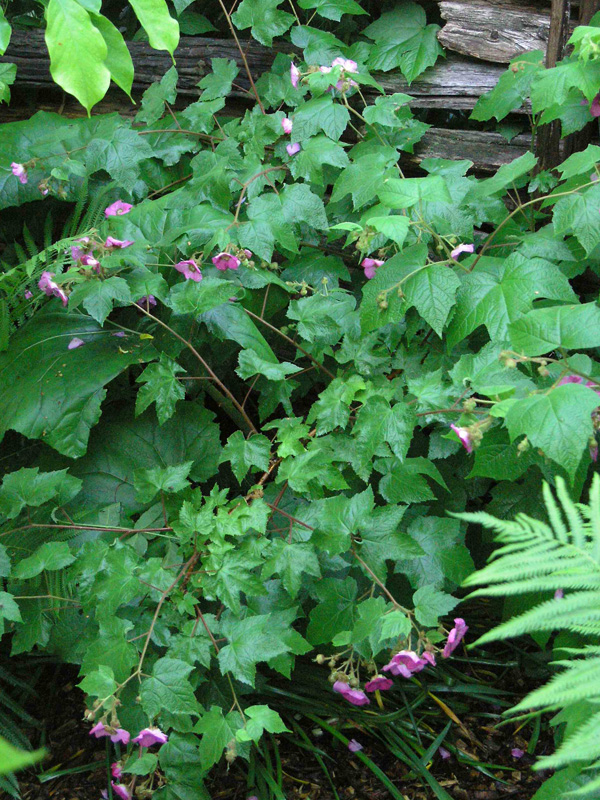
Weeds, Woody > Rubus > Rubus odoratus > Rubus odoratus
Rubus odoratus
Flowering Raspberry
Origin: The flowering raspberry is native to Eastern North America including Quebec, Ontario, New Brunswick and Nova Scotia.
Mike's
Opinion


"
A great woodland edging plant with attractive, clean leaves and fresh pink blooms. It can easily spread where conditions are ideal, but is easily pulled back by hand.
Michael Pascoe, NDP., ODH., CLT., MSc. (Plant Conservation)
"
| Family |
| Rosaceae |
| Genus |
| Rubus |
| Species |
| odoratus |
| Category |
| Weeds, Woody |
| Type |
| Shrub (deciduous) |
| Pronunciation |
| USDA Hardiness Zone |
| 4 |
| Canadian Hardiness Zone |
| 4a |
| RHS Hardiness Zone |
| H7 |
| Temperature (°C) |
| -31 - (-34) |
| Temperature (°F) |
| -25 - (-30) |
| Height |
| 80-170 cm |
| Spread |
| 3 m |
Photographs
Description and Growing Information
Flowering Period
| General Description |
| The flowering raspberry is a beautiful shrub that has very large palmate leaves and a pretty purple flower with a yellow center that is hard to miss. For these reasons, the plant can be often spotted in residential gardens. It can also be cultivated for its fruit which are usually turned into jams or other preservatives. This plant also attracts all sorts of wildlife, including species like the bumble bee, honey bee and native bee. Many birds will also make their nests in the plants as they find it so dense that it provides a safe and suitable home. |
| Landscape |
| Since the flowering raspberry is an attractive looking bush that produces an edible fruit, it is not uncommon to find it in residential gardens. Raspberry plants are fairly aggressive in terms of growth; they grow rapidly and spread quickly due to their tenacious root systems. The flowering raspberry, however, is slightly less aggressive than other Rubus species. It can grow very large (up to 3 m) and has attractive, wide palmate, simple leaves, therefore it can be used as a decorative plant or for its fruit. |
| Cultivation |
| Plant in partial shade with a soil pH that is 6.8 or below. Granular and/or sandy or deep forest loam are ideal. |
| Shape |
| Dense and upright and when mature forms thickets. |
| Growth |
| Fast |
| ID Characteristic |
| Easily recognizable by large maple-looking leaves and their bright purple flowers with yellow centers blooming in May. |
| Pests |
| Rubus odoratus is fairly immune to pests and diseases. Although there is one fungus that is of concern: the honey fungus. The flowering raspberry will attract all kinds of insects pollinators but most common will be the bee. |
| Habitat |
| The flowering raspberry can be found in several eco-zones, including the boreal shield and the Atlantic maritime regions. Its natural habitats are woodland and forest edge. |
| Bark/Stem Description |
| Light beige to brown exfoliating thin bark. |
| Leaf Description |
| Leaves are light-mid green, leaves are simple, palmate, opposite, 7-10 cm wide and rough to the touch. |
| Flower Description |
| The flower of Rubus odoratus is purple, although some of the flowers may show up as pinkish-purple. The flowers are most spectacular in Ontario, where they are much larger and more noticeable than in other Canadian provinces. The blooms are five petalled and are from 5-7 cm in diameter with pronounced yellow anthers. |
| Fruit Description |
| The fruit is very similar to the common raspberry, but it is slightly larger and has a distinctive vanilla taste. |
| Colour Description |
| The plant has green foliage, blooms from pink to purple while the stems are beige to brown. |
| Texture Description |
| A coarse textured plant. |
| Notable Specimens |
| The A. M. Cuddy Gardens, Strathroy, Ontario, Canada. |
| Propagation |
| It can be propagated by seed or hardwood cuttings. Cuttings should be taken in middle to late winter during dormancy, collect pencil thickness stems in 15 cm sections, be sure to remember which is the top and bottom. Apply a number three rooting hormone and stick in sand under bottom heat. |
| Ethnobotanical Uses (Disclaimer) |
| Fruit is edible. |
